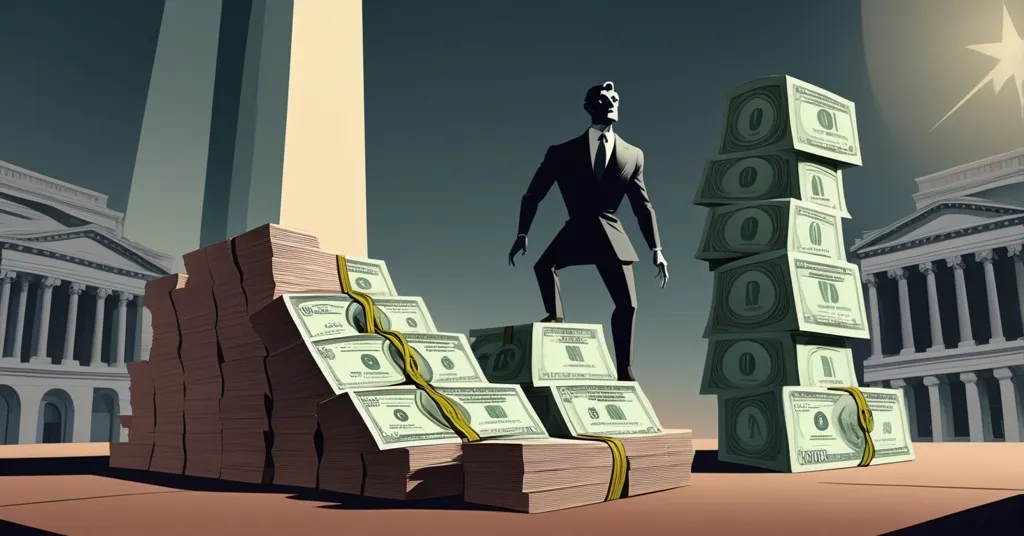Tether’s $33.1B Treasury Buyout: Dominating Stablecoins and Facing U.S. Regulatory Hurdles

Tether’s $33.1 Billion Treasury Buyout: A Power Move in the Crypto World
In 2024, Tether, the issuer of the USDT stablecoin, emerged as the seventh-largest buyer of U.S. Treasury securities, surpassing nations like Germany, Canada, and Mexico with a net purchase of $33.1 billion. This bold move into the Treasury market not only showcases Tether’s growing clout in the financial world but also underscores its significant role in the cryptocurrency ecosystem. Despite facing regulatory hurdles in Europe, Tether reported a record $13 billion net profit last year and saw USDT adoption soar past 400 million users, primarily in developing nations. However, looming U.S. legislation threatens to curb its access to these markets, presenting a potential setback for the stablecoin giant.
- Tether ranked 7th in U.S. Treasury purchases in 2024
- Net purchase of $33.1 billion
- USDT adoption over 400 million users
- 62.45% of the $230 billion stablecoin market
- $13 billion net profit in 2024
- Proposed U.S. legislation threatens Tether’s market access
Tether’s Market Position
Tether’s USDT stablecoin continues to dominate the stablecoin arena, holding over 60% of the entire $230 billion market with a market capitalization of $143 billion. For those new to the crypto space, a stablecoin like USDT is a type of cryptocurrency designed to maintain a stable value, often pegged to a fiat currency like the U.S. dollar. USDT’s widespread adoption, particularly in developing nations where traditional banking is limited, highlights its crucial role in promoting financial inclusion. Yet, Tether’s global influence is not without its challenges, particularly in the face of regulatory scrutiny.
Financial Performance
Tether’s financial performance in 2024 was nothing short of impressive. The company issued 23 billion USDT in the fourth quarter alone, contributing to a total issuance of 45 billion USDT for the year. This aggressive expansion helped Tether achieve a record $13 billion net profit. The net purchase, by the way, refers to the total amount bought after accounting for any sales. This financial strength has allowed Tether to not only bolster its position in the stablecoin market but also make significant investments in U.S. Treasuries.
Imagine this: Tether, a crypto giant, is now rubbing shoulders with nations in the U.S. Treasury market. Tether’s CEO, Paolo Ardoino, isn’t just shrugging off these challenges. He’s positioning Tether’s investments as a boon for U.S. debt markets, arguing, “We’ve done more for financial inclusion than anyone else. And while doing that, we’re buying back U.S. debt. If we were a country, we’d be the 18th largest holder of U.S. Treasuries.” This bold statement from Ardoino highlights Tether’s dual role as a market influencer and a guardian of financial inclusion.
Regulatory Challenges
Despite its financial success, Tether faces potential difficulties in the U.S. due to proposed legislation like the GENIUS Act. This bill, if passed, could restrict offshore stablecoin issuers like Tether from accessing U.S. Treasury markets. The market cap, or the total value of all the cryptocurrency in circulation, of USDT could be impacted by such measures. The legislation aims to establish a comprehensive regulatory framework for stablecoins, reflecting a broader push for regulatory clarity in the crypto industry.
U.S. policymakers, including President Donald Trump and Treasury Secretary Scott Bessent, are advocating for stablecoin-friendly policies to maintain the dollar’s global dominance. This support might be the lifeline Tether needs to navigate the choppy waters of U.S. regulation. However, there are concerns about potential conflicts of interest, as Commerce Secretary Howard Lutnick’s ties to Tether could influence public perception and regulatory scrutiny.
Future Outlook
As Tether continues to push boundaries, the question remains: can it maintain its trajectory amidst growing regulatory scrutiny? Tether’s significant Treasury investments have been met with both applause and skepticism. Critics argue that such heavy involvement in traditional markets might dilute the decentralized ethos that many in the crypto community hold dear. Yet, others see it as a necessary step towards mainstream adoption and a testament to the growing maturity of the crypto space.
The interplay between Tether’s global ambitions and the regulatory landscape will be crucial. Will Tether’s investments in U.S. Treasuries be seen as a stabilizing force or a risky maneuver? Only time will tell, but one thing is clear: Tether isn’t just playing the game; it’s rewriting the rules, and maybe even the rulebook.
Key Takeaways and Questions
- What was Tether’s ranking among U.S. Treasury buyers in 2024?
Tether ranked seventh among U.S. Treasury buyers in 2024.
- How much did Tether purchase in U.S. Treasuries last year?
Tether purchased a net $33.1 billion in U.S. Treasuries last year.
- What percentage of the stablecoin market does USDT hold?
USDT holds 62.45% of the $230 billion total stablecoin market.
- What challenges does Tether face in the U.S.?
Tether faces potential difficulties in the U.S. due to proposed legislation, such as the GENIUS Act, that could limit offshore issuers from accessing U.S. Treasury markets.
- How does Tether contribute to financial inclusion?
Tether contributes to financial inclusion by enabling USDT adoption, which has surpassed 400 million users, mostly in developing nations where traditional banking is limited.
- What is the market capitalization of USDT compared to USD Coin (USDC)?
USDT has a market capitalization of $143 billion, while USD Coin (USDC) has a market cap of $59 billion.
- What is the stance of U.S. policymakers on stablecoins?
U.S. policymakers, including President Donald Trump and Treasury Secretary Scott Bessent, advocate for stablecoin-friendly policies to maintain the dollar’s global dominance.
“We’ve done more for financial inclusion than anyone else. And while doing that, we’re buying back U.S. debt. If we were a country, we’d be the 18th largest holder of U.S. Treasuries.” — Paolo Ardoino, Tether CEO



